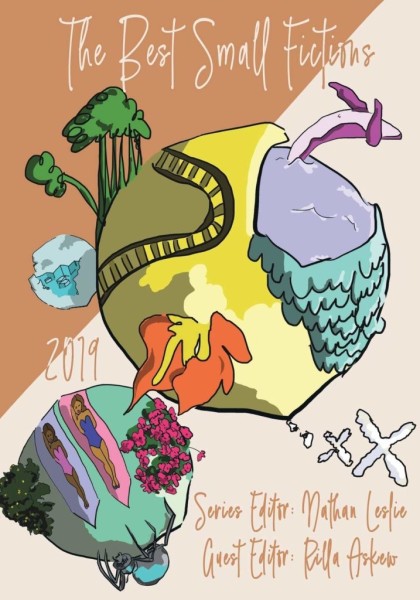
by Frannie McMillan
Readers of The Best Small Fictions 2019 (Sonder Press, 2019) will notice one thing about this year’s collection right off the bat: it is huge. Like, 430 pages huge. Compare that to the 2018 version, which weighed in at a mere 152 pages, and you might wonder what’s up. In his introduction, Editor Nathan Leslie argues that the size of this year’s volume indicates “the current expansive quality of the small fictions universe.” Leslie goes on to address other changes made to this year’s edition, some of which were due in part to the leadership and team-level shifts that occurred as the publication has evolved since its inaugural volume five years ago. Chief among these changes was the expanded inclusivity and cultural diversity of the collection, and the omission of lists of finalists and semi-finalists, from previous years’ anthologies. The resulting collection features what Leslie calls “a super-sized selection” comprised of ten spotlighted stories picked by 2019 guest editor Rilla Askew, a massive main contents of 146 stories, and a closing section of five spotlighted journals chosen by the editing team. Leslie states that adopting this anthology model allowed the team to show off the “wealth of great work being published,” which is a result of a growing interest in small fictions. The writing included in The Best Small Fictions 2019 boasts work from five continents and gives voice to authors representing twenty-six countries.
The ten stories in the opening section of the anthology were culled from the larger list by guest editor, Rilla Askew, who notes in her introductory letter that these spotlighted stories were chosen because of three things: first, these ten stories stayed with Askew long after that initial reading. Second, these stories reflect the range of voices, styles, forms, and cultures present in the current world of small fictions. Third, Askew acknowledges that the works featured in this section represent the most common themes present in the anthology as a whole, including “dispossession, immigration, cultural and sexual violence, lost loves, lost lives, and end-of-the-world anarchy.” In particular, Dionne Irving Bremner’s “Shop Girl” resonated for the richness of language used to describe the speaker’s childhood surroundings in a family-owned grocery store, and for the precise mixture of adolescent frustration and retrospective adult pride powerfully delivered in lines like, “You will always associate work with the coppery smell of animal blood and sawdust and blades that cut fish.” In terms of work that tinkers with form, R.M. Cooper’s “Emergency Instructions” presents readers with what appears on the surface to be an outline for an essay on time travel, but plays with readers’ expectations as the speaker shifts from light-hearted humor, to nostalgia, to a gut-punch of grief. Rewa Zeinati’s “What We Will Tell” is lyrical, more akin to poetry than the other works in spotlighted stories, and serves as a gentle, but brutal, call to action with lines such as this: “We’ll tell them we ate too much and spent too much and considered the street beggar with the drugged child on her chest invisible.”
The main contents–all 136 stories–are organized alphabetically by author’s last name. Again, when compared to the previous year’s edition, The Best Small Fictions 2019 holds the work of almost three times as many writers (53 in 2018). Five of the 136 stories from the main contents are works in translation. Almost two-thirds of the authors use female pronouns in their biographies. Occupations held by writers vary from the predictable: MFA candidate, poet, novelist, professor, teacher, journal/literary magazine editor, to the surprising: semiconductor chip designer, scientist, musician, doctor, photographer, autism paraeducator, single-engine aircraft pilot. As both Leslie and Askew note at the beginning, the size of this anthology means that an incredible range of cultures, styles, forms, and themes are represented within. And, beautifully, common themes emerge as these modern voices intermingle across pages. These are the best stories of this past year, and as such, they reflect the fears and joys, both acknowledged and latent, of our immediate lives. “Twenty Hard Things About Being Married to a White Man” by Chaya Bhuvaneswar (Longleaf Review) intertwines humor and unflinching truth with lines like “He cries when his dog has to get shots at the vet, but not every time it’s mentioned on the news that a Muslim American girl was recently murdered in Virginia.” “Fire” (from Craft) by Brenda Peynado is one of the shorter pieces. Like Bhuvaneswar’s story, “Fire” also features a female voice giving itself over to rage, “turn[ing] others to ash, the word girl meaning fire.” From Mãnoa: A Pacific Journal of International Writing, “A Writer! A Writer!” by Antonio Prata (translated by Katrina Dodson) brilliantly imagines a world where people call out for writers in emergencies the way they might summon a doctor on an airplane. Ayşegül Savaş’ “The Wardrobe” (The Adroit Journal) considers the secret and perhaps unacknowledged relationship between a person and her wardrobe, because “A day wearing glasses is always rainy, no matter the clouds. And some days are pure turquoise, even in the dead of winter.” Tara Isabel Zambrano’s “A Thousand Eyes” (from PANK) is pure, sultry poetry, describing moments spent waiting in line to visit a temple to the Goddess Sati: “A carving of another Goddess overlooks us. Garlands between her breasts, thick thighs, her skin grey, rubbed with time. A draft comes from inside the temple, warm as a tongue.” The thing about these stories, and arguably about small fictions in general, is the immediacy of these pieces. Readers know from the beginning that it won’t be long until the end, which lends a sense of urgency to everything that happens on the page.
The anthology concludes with Q & A interviews of the editors for five spotlighted journals, AFREADA, Cha: An Asian Literary Journal, Conjunctions, matchbook, and New Flash Fiction Review. Each interview focuses on the founding editors’ reasons for starting up their respective publications, asks them to weigh in on the success of their journals, reflect on trends in the genre, and discuss some of the specific stories highlighted in the anthology. In his interview with Meg Pokrass of New Flash Fiction Review, Nathan Leslie asks if she finds the recent surge of flash fiction as a genre surprising. Pokrass’s response hearkens back to Leslie’s introduction: “There are hundreds, maybe thousands of literary journals that publish flash in 2019. What used to be an obscure literary niche is now a form that is taught in university writing programs and published in magazines like The New Yorker. […] One could never have imagined this even three years ago.” This year’s anthology, massive as it might be, is an accurate representation of what the world of flash fiction looks like in 2019.
The Best Small Fictions 2019 is available from Sonder Press and other online shops.
___________________________
 Frannie McMillan’s poetry has appeared in The Coachella Review, K’in Literary Journal, The Indianapolis Review, and others. She is currently at work on her first chapbook, You Ain’t By Yourself. By day, she connects young people with books as a secondary librarian in Richmond, Virginia. You can find her on Twitter @franniemaq.
Frannie McMillan’s poetry has appeared in The Coachella Review, K’in Literary Journal, The Indianapolis Review, and others. She is currently at work on her first chapbook, You Ain’t By Yourself. By day, she connects young people with books as a secondary librarian in Richmond, Virginia. You can find her on Twitter @franniemaq.

 The core workshop of SmokeLong Fitness is all in writing, so you can take part from anywhere at anytime. We are excited about creating a supportive, consistent and structured environment for flash writers to work on their craft in a community. We are thrilled and proud to say that our workshop participants have won, placed, or been listed in every major flash competition. Community works.
The core workshop of SmokeLong Fitness is all in writing, so you can take part from anywhere at anytime. We are excited about creating a supportive, consistent and structured environment for flash writers to work on their craft in a community. We are thrilled and proud to say that our workshop participants have won, placed, or been listed in every major flash competition. Community works.